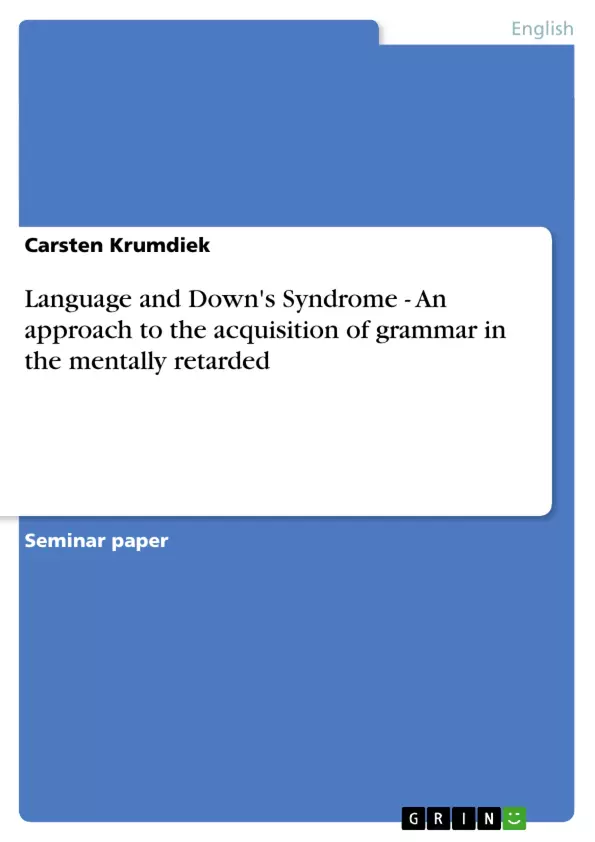The acquisition of language has been a field of study rather new to research, emerging only in the middle of the last century. Among scholars it has been of great interest how people acquire their first language and there have been a great number of controversies what some of the suggested hypotheses are concerned. Another fairly interesting issue, as opposed to normal language acquisition, is the study of people who acquire language even though they are faced with quite particular learning conditions. These people, precisely those who suffer from mental retardation, usually do acquire language; however, this language seems to diverge from the one acquired by typically developing individuals. The present paper will discuss the linguistic problems of individuals with Down syndrome (DS), a genetic disorder, occurring in groups of any social or educational level. It is considered to be the “most common cause of moderate to severe learning disability in childhood”. Approximately one in 700-900 babies is born with Trisomy 21 by mothers of any age.
The study of Down syndrome children in particular, offers several advantages. Due to their physiognomy, subjects with Down syndrome are fairly easy to identify. In addition, language impairment in DS individuals represents a very prominent feature of this group. In this paper, a brief overview on some of the keyfacts shall be given first of all in order to understand the general problems typical of this genetic disorder. Second, the difficulties in speech production will be discussed in relation to physiological and cognitive consequences. The last chapter will deal with the acquisition of morphosyntax in DS individuals as opposed to the grammar in typically developing subjects and will, additionally, consider one particular approach as an account for the apparent differences – the Critical Period Hypothesis.
Inhaltsverzeichnis (Table of Contents)
- I. Introduction
- II. Down Syndrome - An overview
- i. What is Trisomy 21? -A brief history.
- ii. Physical and cognitive consequences.......
- III. Language of children with Down syndrome
- General problems in speech
- Suggestions for Individual differences.
- IV. Morphosyntax in Individuals with Down Syndrome
- i. General morphosyntactic problems..........\n
- ii. The acquisition of grammatical morphemes .....\n
- V. Conclusion...
Zielsetzung und Themenschwerpunkte (Objectives and Key Themes)
This paper investigates the linguistic challenges faced by individuals with Down syndrome (DS), a genetic disorder that affects language acquisition. It delves into the characteristics and impact of Trisomy 21, examining both the physical and cognitive consequences of this condition. The paper explores the general problems in speech production related to DS and examines how these challenges relate to the acquisition of morphosyntax in individuals with DS. The key themes covered in the paper include:- The impact of Down syndrome on language development.
- The challenges faced by individuals with Down syndrome in acquiring language.
- The specific difficulties in morphosyntax acquisition among individuals with Down syndrome.
- The potential role of the Critical Period Hypothesis in understanding the differences in language acquisition between individuals with Down syndrome and typically developing individuals.
- The importance of understanding these challenges for developing effective educational and therapeutic interventions.
Zusammenfassung der Kapitel (Chapter Summaries)
I. Introduction
This chapter introduces the topic of language acquisition, focusing on the specific challenges faced by individuals with Down syndrome. It highlights the unique aspects of studying language acquisition in individuals with mental retardation and provides context for the subsequent discussions on the linguistic problems associated with Down syndrome.II. Down Syndrome - An overview
i. What is Trisomy 21? -A brief history
This section delves into the history of Down syndrome, tracing its discovery and the evolution of understanding this genetic disorder. It explores the progression from early misconceptions to the scientific understanding of Trisomy 21. The chapter discusses the various theories regarding the cause of Down syndrome, emphasizing the importance of recognizing the condition as a genetic anomaly.ii. Physical and cognitive consequences
This section examines the physical and cognitive consequences of Down syndrome, highlighting the characteristic features of individuals with this disorder. It discusses the potential for congenital heart defects, the unique physiognomy associated with Down syndrome, and the various physical challenges individuals may face. The chapter also provides an overview of the cognitive aspects of Down syndrome, noting the typical range of IQ scores among individuals with this condition.III. Language of children with Down syndrome
This chapter focuses on the specific linguistic difficulties experienced by individuals with Down syndrome. It explores the general challenges in speech production, including the potential for articulation problems, limited vocabulary, and difficulties with sentence structure. The section also addresses the need to consider individual differences in language development among individuals with Down syndrome.IV. Morphosyntax in Individuals with Down Syndrome
i. General morphosyntactic problems..........\n
This section examines the specific challenges individuals with Down syndrome face in acquiring morphosyntax. It focuses on the areas where their grammatical development might deviate from that of typically developing individuals, discussing the potential impact of cognitive and linguistic limitations on their acquisition of grammatical morphemes.ii. The acquisition of grammatical morphemes .....\n
This section delves deeper into the difficulties individuals with Down syndrome face in acquiring grammatical morphemes. It explores how the acquisition of these morphemes might be delayed or incomplete compared to typically developing individuals. The chapter also examines the relevance of the Critical Period Hypothesis in understanding these differences.Schlüsselwörter (Keywords)
The key terms and concepts associated with this paper include Down syndrome, Trisomy 21, language acquisition, speech production, morphosyntax, grammatical morphemes, critical period hypothesis, and mental retardation. These terms represent the core themes and areas of focus in this exploration of language acquisition in individuals with Down syndrome.- Citar trabajo
- Carsten Krumdiek (Autor), 2007, Language and Down's Syndrome - An approach to the acquisition of grammar in the mentally retarded, Múnich, GRIN Verlag, https://www.grin.com/document/72933



